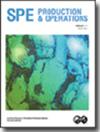Experimental Investigation of Oil-Water Two-Phase Flow in Horizontal, Inclined, and Vertical Large-Diameter Pipes: Determination of Flow Patterns, Holdup, and Pressure Drop
IF 1.3
4区 工程技术
Q2 ENGINEERING, PETROLEUM
引用次数: 1
Abstract
Liquid-liquid phase flow in pipes merits further investigation as a challenging issue that has very rich physics and is faced in everyday applications. It is the main problem challenging the fluid flow mechanism in the oil and gas industry. The pressure gradient of liquid flow and flow pattern are still the topics of numerous research projects. In this paper, the emphasis is on further investigation to research the flow pattern, water holdup (HW), and pressure decrease for vertical, horizontal, and inclined flow directions of oil and water flows. Test section lines of 4.19-in. (106.426 mm) inner diameter (ID) and 5-m horizontal, 5-m inclined, and 5-m vertical test sections were serially connected. The experiments were conducted at 40°C using 2-cp viscosity oil and tap water, and oil density of 850 kg/m3, at the standard conditions. Fifty experiments were executed at 250 kPa at the multiphase flow test facility, with horizontal, upward (0.6° and 4°), downward (−0.6° and −4°) hilly terrain and vertical pipes. The oil and water superficial velocities were changed between 0.03 and 2 m/s. This evidence was obtained using video recordings; the flow patterns were observed, and the selection of each flow pattern was depicted for each condition. For horizontal and inclined flow, new flow patterns were documented (e.g., oil transfer in a line forms at the top of the pipeline, typically at high water rate, and water transfer at the lower part of the pipe at a high oil rate). The data were taken at each flow condition, resulting in new holdup and pressure drop. The results show that the flow rate and the pipe inclination angle have major impacts on the holdup and pressure drop performances. In the vertical flow, a clear peak was demonstrated by experiments after the superficial oil velocity reached a certain value. This peak is known as phase inversion point, where after this peak, the pressure starts declining as the superficial oil velocity increases. Also, slippage has been observed after varying inlet oil flow rates between the two phases. The experiments showed that with minor alteration in the inclination angle, the slippage was significantly changed. This study presented new experimental results (measured mainly at horizontal, inclined, and vertical flow conditions) of HW, flow pattern, and pressure drop. These findings are key evidence of the evolving oil-water and flowline estimate models.水平、倾斜和垂直大直径管道中油水两相流的实验研究:流型、截留率和压降的确定
管道内液-液相流动是一个具有丰富物理性质且在日常应用中面临的具有挑战性的问题,值得进一步研究。这是油气工业中流体流动机理研究面临的主要问题。液体流动的压力梯度和流型仍然是许多研究项目的主题。本文的重点是进一步研究油水流动在垂直、水平和倾斜流动方向上的流态、持水率和压降。4.19英寸的测试断面线。(106.426 mm)内径(ID)与5m水平、5m倾斜、5m垂直试验段串联。实验条件为:在标准条件下,在40℃条件下,使用2-cp粘度的油和自来水,油的密度为850 kg/m3。在250 kPa的多相流试验装置中,在水平、向上(0.6°和4°)、向下(- 0.6°和- 4°)的丘陵地形和垂直管道中进行了50次实验。油水表面速度在0.03 ~ 2 m/s之间变化。这一证据是通过录像获得的;观察了流型,并描述了每种条件下每种流型的选择。对于水平流和倾斜流,记录了新的流动模式(例如,在管道顶部以直线形式进行石油转移,通常是在高出水量时,在管道下部以高出水量进行水转移)。在每种流动条件下采集数据,得出新的含率和压降。结果表明,流量和管道倾角对含率和压降性能影响较大。在垂直流动中,实验表明,在表面油速达到一定值后,出现一个明显的峰值。这个峰值被称为相反转点,在这个峰值之后,随着表面油速度的增加,压力开始下降。此外,在两相之间改变进口油流量后,还观察到滑移。实验结果表明,在倾角变化不大的情况下,滑移量有明显变化。本研究提出了新的实验结果(主要在水平、倾斜和垂直流动条件下测量),包括HW、流型和压降。这些发现是不断发展的油水和流线估算模型的关键证据。
本文章由计算机程序翻译,如有差异,请以英文原文为准。
求助全文
约1分钟内获得全文
求助全文
来源期刊

Spe Production & Operations
工程技术-工程:石油
CiteScore
3.70
自引率
8.30%
发文量
54
审稿时长
3 months
期刊介绍:
SPE Production & Operations includes papers on production operations, artificial lift, downhole equipment, formation damage control, multiphase flow, workovers, stimulation, facility design and operations, water treatment, project management, construction methods and equipment, and related PFC systems and emerging technologies.
 求助内容:
求助内容: 应助结果提醒方式:
应助结果提醒方式:


